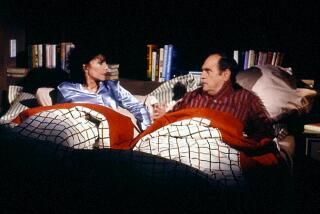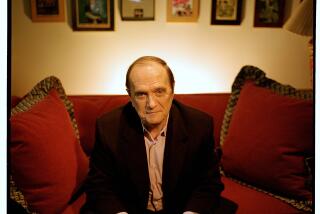Life as a Media Baron : Biography of a shy, secretive man just scratches the surface : NEWHOUSE: All the Glitter, Power, and Glory of America’s Richest Media Empire and the Secretive Man Behind It, <i> By Thomas Maier (St. Martin’s Press: $24.95; 446 pp.)</i>
- Share via
This intriguing, damning but ultimately unsatisfying biography of the man who is arguably the most powerful media baron in the United States reminds me of all those unauthorized biographies of Howard Hughes. Because Hughes was an obsessive recluse, readers learned little about him in those books that wasn’t speculation, rumor, innuendo and amateur psychoanalysis. For the most part, Hughes’ would-be biographers filled their pages with what purported to be inside accounts of his various creations and acquisitions--everything from RKO, TWA, Hughes Aircraft and the hotels of Las Vegas to the “revolutionary” brassiere he designed for actress Jane Russell.
Thomas Maier, an investigative reporter for Newsday in New York, falls--indeed jumps--into the same, perhaps inevitable trap in “Newhouse.” Sixty-seven-year-old Samuel I. (Si) Newhouse Jr., the multi-billionaire who now runs the empire created by his once-impoverished father, is not really a recluse. Nor is he the bizarre eccentric that Hughes was. There have been no stories about his having six-inch-long fingernails or a phobia about germs. But he is shy, secretive and (like his company) private. Because his Conde Nast empire includes some of the most glamorous magazines in America--the New Yorker, Vanity Fair, Vogue--but he grants few interviews himself, Newhouse has become a mystery figure of sorts among the New York glitterati.
Maier says on the first page of his book: “Si Newhouse never responded to a written request for an interview.” Newhouse’s brother and second-in-command, Donald, and other family members “had much the same reaction,” as did many Newhouse executives, Maier says. Thus, despite the author’s admirably exhaustive efforts--”examining hundreds of pages of court testimony and documents, conducting more than 250 interviews and reading numerous books, newspapers and periodicals”--the book lacks any true sense of who Si Newhouse really is and what he really wants, apart from money.
As with the Hughes books, one learns a great deal in “Newhouse” about the Newhouse creations and acquisitions--which include the country’s largest book publishing group (Random House, Knopf, Pantheon, Crown); two dozen newspapers (among them, dailies in Cleveland, Portland, Newark and New Orleans), and assorted television holdings. But one learns precious little of consequence about Si Newhouse himself, other than that he has a valuable art collection, a strong commitment to such verities as family and hard work, and a penchant for firing longtime editors. (His spectacular dismissals have entered publishing lore: Grace Mirabella, who had spent 36 years at Vogue, heard she was fired only when it was announced on television; the ousting of both William Shawn, the legendary New Yorker editor, and Andre Schiffrin, the publisher of Pantheon Books, triggered in-house uprisings.)
Early to bed, early to rise, Newhouse usually gets to his office before dawn, and there’s a delightful scene in the book in which guests at a Newhouse cocktail party are alerted that it’s time to leave by a dimming of the lights in his “grand duplex”--at 8 p.m.!--so Newhouse won’t miss his 9 o’clock bedtime.
Such personal anecdotes are all too few, alas. In fact, the most vivid portrait in this book is not of Si Newhouse--nor even of his father or brother--but of Roy Cohn, who rose to infamy with Sen. Joseph McCarthy and became a longtime close friend and legal adviser to Si Newhouse.
The Cohn sections contain the best material in the book, in particular the behind-the-scenes role that Cohn played in getting Newhouse’s Cleveland Plain-Dealer to shamefully back away from its own Page 1 expose on Jackie Presser, the Teamsters Union boss who had ties to both the Mafia and the FBI. But even with the rich (and unseemly) Newhouse/Cohn relationship, Maier is often reduced to surmise and speculation.
Cohn’s homosexuality “didn’t seem” to disturb Newhouse, he writes. And: Newhouse “likely knew . . . Roy’s secret.” And--in writing about how Cohn used the Newhouse-owned Parade magazine to attack the Internal Revenue Service when it was investigating Cohn: Whether Newhouse agreed with this diatribe “is not certain.”
Maier is on sounder--and more fertile--ground when he can rely on documents, as in his painstaking reconstruction of the Newhouse family’s own battle against the IRS. When Newhouse Sr. died, the estate was hit with a $1-billion tax bill. But Newhouse Jr. and his shrewd attorneys managed to whittle the bill to $48 million.
Maier is also effective in using the Newhouse newspapers as a prototype for the homogenization of the American media and a case study on the dangers of monopoly ownership. Competition can lead to excess and sensationalism, of course, but it can also force newspapers to take seriously their civic responsibilities, to dig deep and report broadly, if only out of fear of being beaten. Thus, after describing the Newhouse family’s role in the demise of the Cleveland Press in 1982, Maier writes: “With the collapse of competition and a certain lock on the market, newspapers like Newhouse’s Cleveland Plain Dealer could afford a ‘take it or leave it’ approach to serving the public.”
Maier describes the Newhouse newspaper and broadcast holdings as “the biggest part of the Newhouse empire,” but he devotes only a relatively small portion of his book to Si Newhouse’s role in these ventures. The book has 13 chapters, and Maier devotes seven of them to accounts of the high-profile controversies surrounding Newhouse’s personnel moves at the New Yorker, Vanity Fair and his book-publishing companies. Maier is thus guilty of the very sin for which he so self-righteously condemns the Newhouse-run magazines: pandering to the public with glitter instead of substance.
Moreover, Maier seems determined to paint the most unflattering portrait possible of Newhouse; he’s variously depicted as a “buffoon,” as “the bumbling son of the wealthy owner” and as someone to be condemned for his “abuse of a public trust, his tolerance and sometimes deliberate participation in ethically vacuous deals.”
Although he has done little to rescue his newspapers from the resolute mediocrity they represented in his father’s day, Newhouse has been a major and not altogether malignant force in the magazine world. However much one may lament the disappearance of the old New Yorker and the royal flash and trash of the new Vanity Fair, both magazines have carried some very good journalism under Newhouse’s aegis, and it’s entirely possible that neither would have survived in the current media climate without the infusion of Newhouse’s money and his editors.
Maier gives Newhouse so little credit that after all his criticism, the reader is startled to find the author saying, in the final words of the book, that Newhouse’s “most remarkable achievement” has been his “ability to surprise, to overcome his personal fears and limitations, to exceed the expectations of those who thought they knew him best. For so much of Si Newhouse’s life, as he often professed, has been about the willingness to change.”
It’s as if, having buried Newhouse, Maier felt compelled to praise him.
More to Read
Sign up for our Book Club newsletter
Get the latest news, events and more from the Los Angeles Times Book Club, and help us get L.A. reading and talking.
You may occasionally receive promotional content from the Los Angeles Times.







